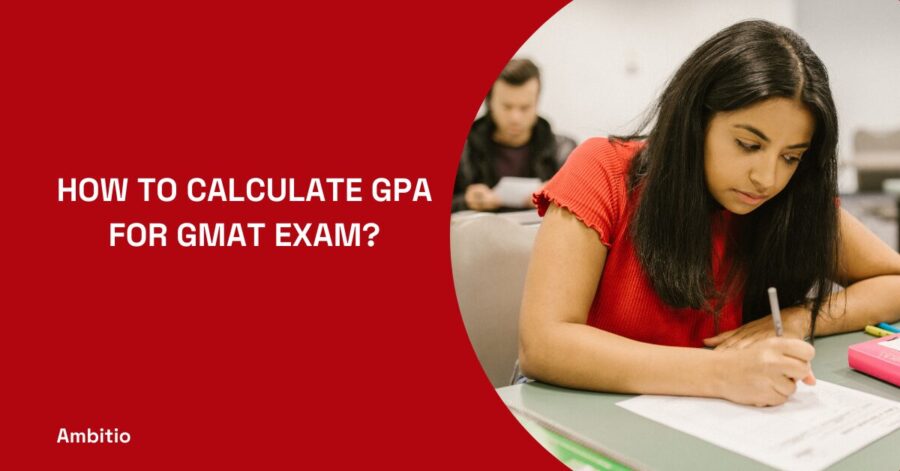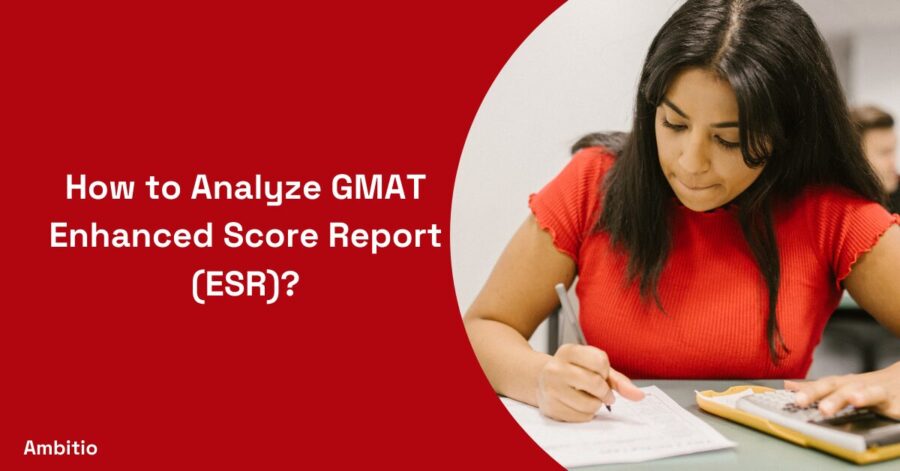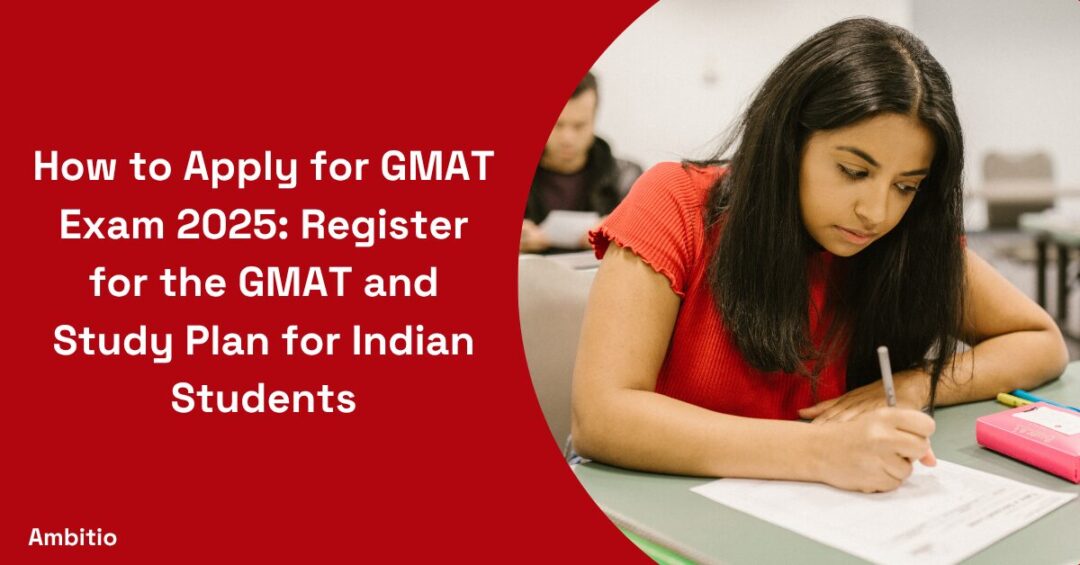20 May 2025
8 minutes read
8 Best GMAT Percentage Tricks for Indian Students
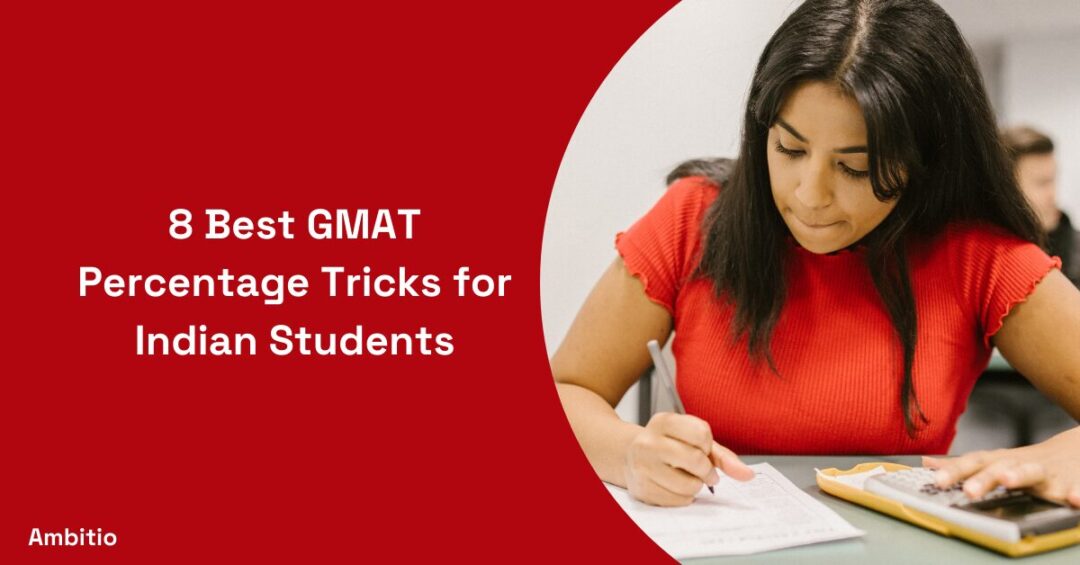
Key Takeaways
- GMAT percentage tricks help simplify complex questions using smart shortcuts and pattern recognition for quicker solutions.
- GMAT percentage tricks improve your quant score by enhancing accuracy and reducing calculation time during the test.
- GMAT percentage tricks rely on understanding ratios, base values, and common percentages used in exam-level problems.
Did you know that the percentage questions comprise approximately 20% of the GMAT Quantitative section? For most test takers, these questions are a stumbling block and often cause anxiety and waste crucial time in the test.
Whether it’s finding the calculation of percent change, arriving at final prices, or solving some complex algebra problems about percentages, these questions seem slippery. Don’t let percentages scare you away from your targeted good GMAT score and MBA dreams.
This guide helps you destroy percentage questions and boost your quant section performance. We go through all aspects—from the basics to GMAT advanced strategies—to help you confidently approach these problems. Ready to turn percentages from your weakness into your strength?
What Do They Test In GMAT Percentage Questions?
Percentage questions in the GMAT exam and GMAT quant are fundamental – you have to face them, and you have no other options. This establishes how much you know to manipulate numbers and get a solution for a real-world problem.
Very often, questions on percentages, though appearing deceptively simple, may be quite tricky and need a sure mastery of percentages, fractions, and decimals by test takers.
The three types that come up repeatedly and seem to test takers commonly have trouble with are per cent increase/decrease and calculation of per cent of per cent.
The GMAT exam uses such questions to assess your math reasoning abilities and how you apply percentage concepts to realistic scenarios, for instance, price changes, profit, or savings account balances.
Here are six key aspects that GMAT percentage questions typically test:
1. Basic percentage calculations
You’ll need to be comfortable converting between percentages, decimals, and fractions. For example, know that 15% is the same thing as 0.15 or as 15/100. Questions might be something times y percent or what percent x is of y.
Common practice questions involve finding the correct multiplier for a percentage: you will use 1.3 for a 30% increase; you will use 0.85 for a 15% decrease.
2. Percent change
GMAT Students appearing in the GMAT exam should be familiar with percent change, both increase and decrease. The new value subtracted from the old value divided by the old value times 100 gives us the percent change.
For example, if the price suddenly doubles, an increase of 100%. Things can get pretty sneaky when multiple percentage changes are involved in the question or it asks for the original value after a percentage change has occurred.
3. Compound percentage changes
Your exam might present scenarios where there is more than one percentage change, one right after the other. For example, if your savings account grows by 5% one year and then by 3% the following year, you would not add 8% to what you had.
Instead, you’d have to apply the percentages sequentially: first, multiply by 1.05, then by 1.03 – that way you can easily maximize your GMAT score.
4. Percentage word problems
Often, GMAT percentage questions come in the form of word problems, and you have to read through the words to pull out an expression relevant to your GMAT math. These might include situations around profit or loss, changes in price, or population growth.
The key to these exercises is being able to comprehend what the question is asking and to identify given important information.
5. Reverse percentage questions
Some questions give you a final value after a percentage change and ask you to find the original value. This is working backwards, which can feel kind of weird. For instance, if a price went up by 20% to $240, you would have to figure out that the original price was $240/1.2, not just $240 minus 20%.
6. Per Cent of a Per Cent
The new GMAT format likes to see if you can take a per cent of another per cent. For example, the question may tell you that a store gives a 20% discount and then another 15% off of THAT price.
To solve this, you’d need to apply the percentages one after the other: first 0.8 (since it is at a 20% discount), then 0.85 more (since the additional discount was 15%).
8 Tricks For Percentage Change Practice Questions
These percentage problems can be quite tricky, often involving complex scenarios that test your ability to calculate per cent increases, decreases, and compound changes.
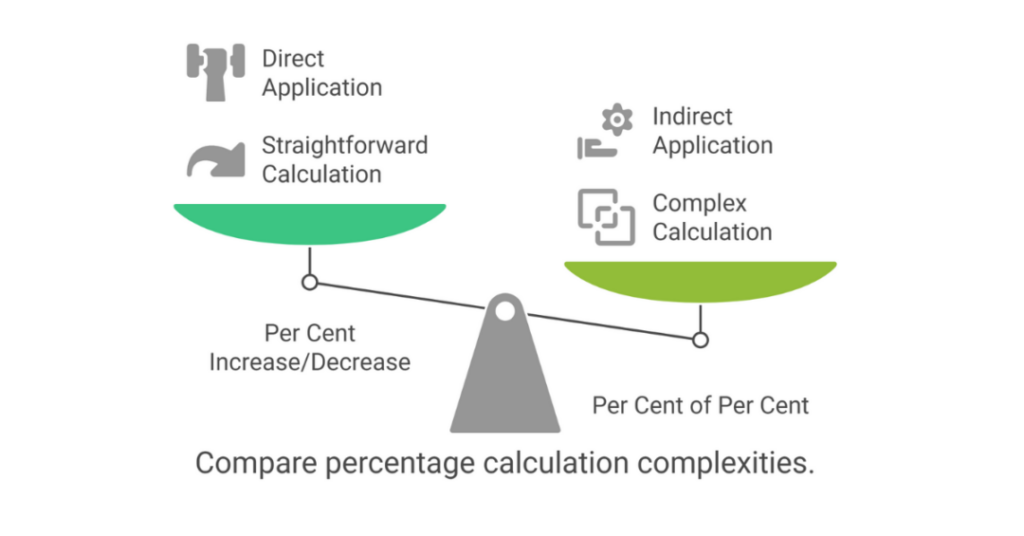
Whether you’re dealing with profit or loss, changes in savings account balances, or price fluctuations, having a solid grasp of percentage calculations is essential.
By learning and applying these tricks, you can approach GMAT percentage practice questions with confidence, potentially raising your GMAT score and improving your performance on the quantitative reasoning section of the GMAT.
While the GMAT exam doesn’t deduct your marks, so test your luck if you face problem finding a solution
1. Convert percentages to decimals
When working with percentages, it’s often easier to convert them to decimals. For example, 15% becomes 0.15, and 4% becomes 0.04.
This simplifies calculations, especially when dealing with multipliers. To find the correct multiplier for an increase, add the decimal to 1 (e.g., a 30% increase has a multiplier of 1.3).
For a decrease, subtract the percent decrease from 1 (e.g., a 15% decrease has a multiplier of 0.85). This trick is particularly useful when you’re trying to calculate compound percentage changes or when dealing with percent of a percent problems.
2. Use the “percent change formula”
To calculate percent change, use the formula: (New Value – Original Value) / Original Value x 100. This works for both increases and decreases. For instance, if a price suddenly doubles from $50 to $100, you’d calculate: (100 – 50) / 50 x 100 = 100%.
This represents an increase of 100%. Remember, when the question is asking for percent change, always divide by the original value, not the new price. This trick will help you score the maximum marks in GMAT exam.
3. Reverse engineer with given information
Sometimes, you’ll be given the final amount and asked to find the original value or the percent change. In these cases, work backwards. If you know a price increased by 30% to $130, divide $130 by 1.3 to find the initial price.
This trick is particularly useful in GMAT practice word problems where you’re given the ending number and need to determine the starting value to solve the question.
4. Recognize consecutive percentage changes
When dealing with multiple percentage changes, don’t simply add or subtract the percentages. Instead, multiply the multipliers. For example, if your savings account increases by 5% one year and 3% the next, you’d multiply your original amount by 1.05, then by 1.03.
This gives you a compound multiplier of 1.0815, representing a total increase of 8.15%, not 8%.
5. Use benchmarks for quick estimations
Familiarize yourself with common percentages and their fractional equivalents. For instance, 25% is 1/4, 20% is 1/5, and 10% is 1/10. This can help you quickly estimate answers or check if your calculated answer makes sense.
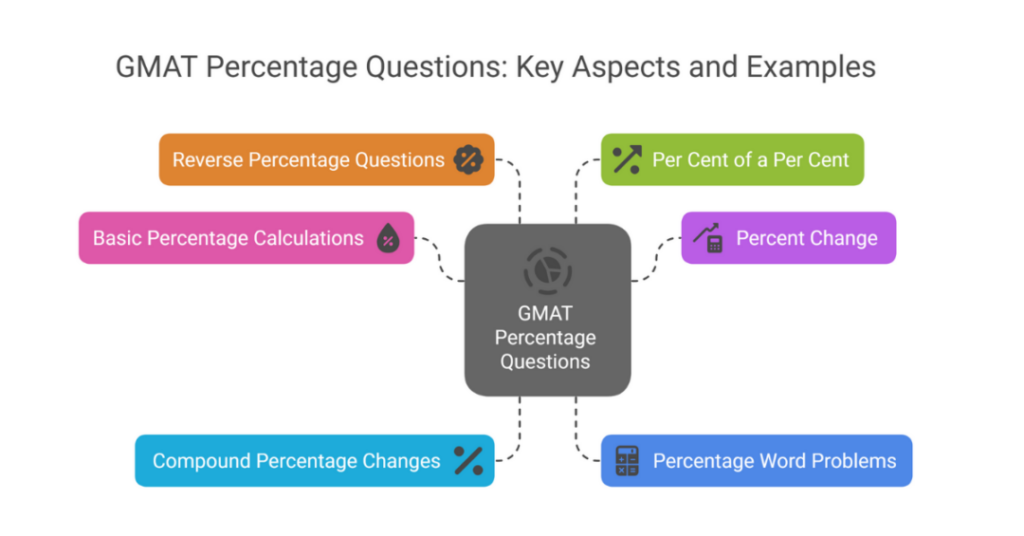
When a question like this appears on a GMAT diagnostic test and asks for a rough estimate or when you’re running short on time, this trick can be a lifesaver – Too much mathematics? But GMAT is even for non-math background student.
6. Be careful with percent of a percent
When a question involves taking a percent of another percent, be sure to multiply the percentages rather than add them. For example, if a store offers a 20% discount and then an additional 10% off the discounted price, the total discount isn’t 30%.
Instead, you’d calculate it as: 1 – (0.8 x 0.9) = 0.28 or 28%. This trick is particularly important in problems involving compound discounts or multiple percentage changes.
7. Use an algebraic approach for complex problems
For more complicated percentage problems, setting up an equation can be helpful. Let x represent the unknown value you’re trying to find. For instance, if a price increases by 20% and the new price is $240, you can set up the equation: x(1.2) = 240.
Solving for x gives you the original price. This approach is particularly useful when dealing with GMAT word problems that involve multiple steps or when you need to find an original value after several percentage changes.
8. Practice with different question types
GMAT percentage questions come in various forms, from straightforward calculations to complex word problems. Make sure to practice with a wide range of Free GMAT practice questions.
This includes problems concerned with calculating profit or loss, questions about changes in interest rates or savings account balances, and scenarios involving price increases and decreases.
The more diverse your practice, the better prepared you’ll be for any percentage question the GMAT exam throws your way – you will solve the problems with ease. Create a 45 days GMAT study plan for better results.
4 GMAT Percentage Questions Examples With Answer
These practice questions often test your ability to apply mathematical concepts to real-world scenarios, such as calculating percent increases and decreases, solving for compound percentage changes, and analyzing profit or loss.
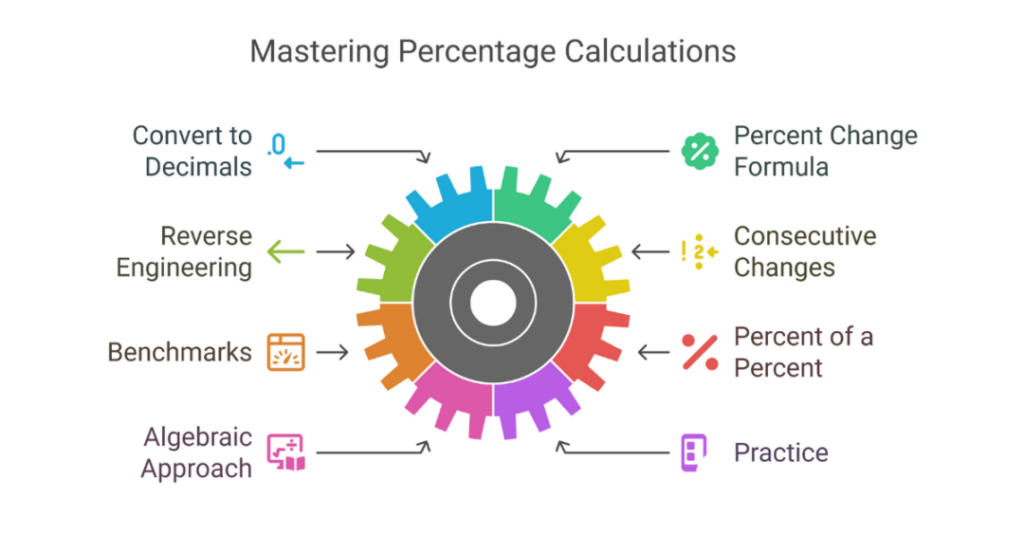
By consistently practicing, you can develop a deeper understanding of percentages, improve your problem-solving speed, and enhance your overall test performance. To help you get started, here are four GMAT percentage question examples with solutions, demonstrating various concepts and techniques.
Question 1: A store marks up its products by 40% of the cost price. If a customer gets a 25% discount on the marked price, what per cent of the cost price does the customer pay?
Solution:
- Let’s say the cost price is $100 (for easy calculation).
- Marked price = $100 + 40% of $100 = $140.
- After 25% discount: $140 – 25% of $140 = $140 – $35 = $105.
- The customer pays $105 for an item that cost $100.
- Percent of the original cost price paid = (105/100) x 100 = 105%.
Answer: The customer pays 105% of the cost price.
Question 2: If the price of a product increases by 20% and then decreases by 15%, what is the overall percentage change?
Solution:
- First increase: multiply by 1.20.
- Then decrease: multiply by 0.85.
- Overall change: 1.20 x 0.85 = 1.02.
- This represents an increase of 2% overall.
Answer: The overall change is a 2% increase.
Question 3: A company’s profits increased by 15% in 2022 compared to 2021. If the profits in 2022 were $230,000, what were the profits in 2021?
Solution:
- Let x be the profits in 2021.
- We know: x + 15% of x = $230,000.
- This can be written as: 1.15x = $230,000.
- Solving for x: x = $230,000 / 1.15 = $200,000.
Answer: The profits in 2021 were $200,000.
Question 4: In a class, 60% of the students are girls. If 10 more boys join the class, the percentage of girls drops to 55%. How many students were originally in the class?
Solution:
- Let x be the original number of students.
- Girls = 0.60x, Boys = 0.40x.
- After 10 boys join: 0.60x / (x + 10) = 0.55.
- Cross multiply: 0.60x = 0.55x + 5.5.
- 0.05x = 5.5.
- x = 5.5 / 0.05 = 110.
Answer: There were originally 110 students in the class.
Conclusion
To wrap up, mastering GMAT percentage questions isn’t just about memorizing formulas—it’s about developing a keen sense of numbers and their relationships.
The tricks we’ve covered, from converting percentages to decimals to recognizing compound changes, are your toolkit for tackling these tricky problems.
But here’s the real secret: consistent practice is key. As you work through more questions, you’ll start to see patterns and develop intuition that goes beyond mere calculation.
Remember, the GMAT isn’t just testing your math skills; it’s assessing your ability to think critically under pressure. So as you practice, focus on understanding the underlying concepts rather than just getting the right answer.
Master the GMAT and pave your way to MBA excellence with Ambitio. Our platform offers in-depth study materials, practice questions, and tailored feedback, focusing on the areas you need to strengthen to boost your score and secure your place at a top business school.
FAQs
What are the best GMAT percentage tricks to remember for test day?
The best GMAT percentage tricks include converting percentages to fractions, using 10% as a base, and estimating smartly. These GMAT percentage tricks can help save time and boost accuracy.
How can GMAT percentage tricks improve my quant score?
Are GMAT percentage tricks applicable to data sufficiency questions?
What formulas should I know for GMAT percentage tricks?
Do GMAT percentage tricks help with compound percentage problems?
Can GMAT percentage tricks help me avoid silly mistakes?
Yes, GMAT percentage tricks offer structured shortcuts that reduce manual errors. Learning reliable GMAT percentage tricks can prevent mistakes in fast-paced testing situations.
Where can I practice GMAT percentage tricks effectively?
You can practice GMAT percentage tricks through official guides, online platforms, and prep apps. Regularly applying GMAT percentage tricks in mock tests improves retention and performance.

You can study at top universities worldwide!
Get expert tips and tricks to get into top universities with a free expert session.
Book Your Free 30-Minute Session Now! Book a call now















